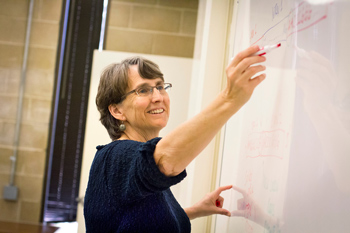Biology Students Join Hundreds of Undergraduates Across Nation to Co-Author Genomics Research Paper
May 20, 2015
By Kim McDonald

Stephanie Mel, a teaching professor in the Division of Biological Sciences, designed and taught a new biology course called "Research Explorations in Genomics" to allow UC San Diego undergraduates to conduct original research in a classroom setting while becoming co-authors in a peer‐reviewed scientific journal.
Erika Johnson, UC San Diego
An unusual genomics research paper published this month by 940 students at 63 universities around the nation provided 16 undergraduate biology students at UC San Diego with an opportunity to conduct original research in a classroom setting, while becoming co-authors in a peer‐reviewed scientific journal.
Published in the May issue of the journal G3: Genes|Genomes|Genetics, the study conducted by the undergraduate student researchers detailed the evolution of an unusual chromosome in fruit flies. It was made possible by the Genomics Education Partnership, a Howard Hughes Medical Institute-funded collaboration with the biology department and Genome Sequencing Center of Washington University in St. Louis, which coordinated the work.
"This collaboration provided a genuine research experience in our undergraduate biology classroom," said Stephanie Mel, a teaching professor in the Division of Biological Sciences at UC San Diego who in 2010 designed and taught a new biology course called "Research Explorations in Genomics" to take part in this effort.
In that course, the 19 undergraduate biology students taught by Mel and helped by a master's student teaching assistant, conducted the UC San Diego portion of the research study. It was an experiment for the instructors as well as the students. And both loved the new approach.
"I got extremely positive feedback from the students in the course," Mel added. "Since so many of their other biology courses had several hundred people in them, it was an extraordinary opportunity for the students at UC San Diego to learn in a small, highly interactive environment, and to learn in the context of solving a real life research problem."
Recent reports on undergraduate education have emphasized the crucial role of providing authentic research experiences, where students can learn more than from the traditional textbook lectures and canned experiments.
While faculty at the various universities that collaborated in the effort oversaw the project and drafted the paper, each of the 940 students listed as a co‐authors performed original research and read and approved the manuscript before submission. Many students also provided important comments that were incorporated into the final version.
The students tackled the investigation of the "dot" chromosome of Drosophila fruit flies. The dot chromosome gets its name from its tiny size; next to the other fruit fly chromosomes, it looks like a compact dot. Scientists are interested in the dot chromosome because its DNA is tightly packaged in a form called heterochromatin — a state normally linked with relatively inactive genome regions that contain only a few rarely expressed genes. But despite being packed into heterochromatin, a large region of the dot chromosome carries a similar density of actively expressed genes compared to other, non‐heterochromatic parts of the fruit fly genome. Non‐heterochromatic DNA is known as euchromatin.
How has this unusual state affected evolution of the dot chromosome genes? To investigate, the collaboration of students set out to compare the dot chromosome to a euchromatic region from a different chromosome. But this exploration required a high quality genome sequence from several different Drosophila species, not just Drosophila melanogaster, the species in which the dot chromosome has been most intensively studied. Draft genome sequences for other Drosophila species were already publicly available, but because the dot chromosome carries many repetitive sequences, the genome data was sometimes unreliable. That's because repeat sequences cause trouble for the software that stitches together the fragments of raw sequence data — like a jigsaw puzzle with many pieces of the same color and shape, it's hard to figure out which fragments belong where.
In this case, humans do a better job than computers. The collaboration was able to correct errors in the draft genome assembly by breaking the work up into chunks and distributing it among hundreds of students. The students carefully examined each region they were assigned and paid attention to small differences in repeated sequences that gave the students clues on how to put the puzzle together.
"From my perspective, it was a privilege to be able to involve undergraduates in a genuine research experience in a regular class setting," said Mel. "And to have this result in student authorship on a scientific publication is tremendously exciting."
Said one of the UC San Diego biology students, Jim Liu, "It was a unique educational and empowering experience that set itself FAR apart from and above the bulk of the ‘memorize-regurgitate-repeat' undergraduate experience."
